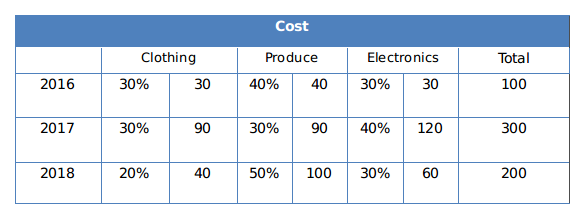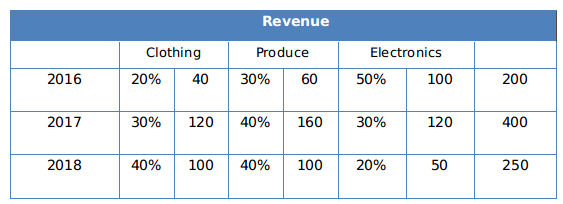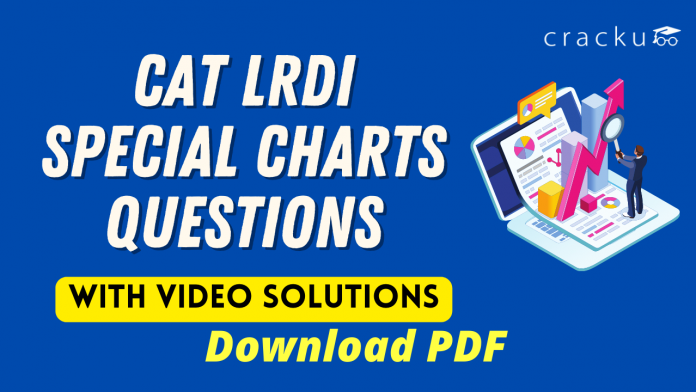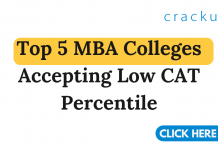Special Charts is one of the important types of charts in the CAT LRDI section. These sets are usually not very tough, and hence you should not miss out on the questions from Special charts (spider charts, bubble charts, etc). Firstly, understand the data given in the Special Charts. Also, learn the ways to Represent the data in Special Charts. You can check out these CAT Special Charts-based questions from the CAT Previous year’s papers. In this post, we will look at some important Special Charts Sets in the CAT LRDI section. These are a good source of practice for CAT preparation; If you want to practice these questions, you can download this Special Charts Questions for CAT LRDI PDF along with the detailed solutions (and video solutions) below, which is completely Free.
Download Special Charts Questions for CAT
Enroll for CAT 2022 Online Course
Instructions
To compare the rainfall data, India Meteorological Department (IMD) calculated the Long Period Average (LPA) of rainfall during period June-August for each of the 16 states. The figure given below shows the actual rainfall (measured in mm) during June-August, 2019 and the percentage deviations from LPA of respective states in 2018. Each state along with its actual rainfall is presented in the figure.

Question 1: If a ‘Heavy Monsoon State’ is defined as a state with actual rainfall from June-August, 2019 of 900 mm or more, then approximately what percentage of ‘Heavy Monsoon States’ have a negative deviation from respective LPAs in 2019?
a) 42.86
b) 75.00
c) 57.14
d) 14.29
1) Answer (A)
Solution:
The states which satisfy the condition given in the question:
Maharashtra, Mizoram, Sikkim, Goa, Arunachal, Kerla, Meghalaya…..7 states
The ‘Heavy Monsoon States’ have a negative deviation: Arunachal, Kerla, Meghalaya
= 3/7×100=42.86%
Option A
Question 2: If a ‘Low Monsoon State’ is defined as a state with actual rainfall from June-August, 2019 of 750 mm or less, then what is the median ‘deviation from LPA’ (as defined in the Y-axis of the figure) of ‘Low Monsoon States’?
a) -10%
b) 10%
c) -20%
d) -30%
2) Answer (A)
Solution:
All the states which satisfy the condition for ‘ Low monsoon state’ are Gujrat (+25%), Karnataka (+20%), Rajasthan (+15), MP (+10%), Assam (-10%), WB (-30%), Jharkhand (-35%), Delhi (-40%) and Manipur (-60%).
The median of all the deviation is -10% Assam.
Question 3: What is the average rainfall of all states that have actual rainfall of 600 mm or less in 2019 and have a negative deviation from LPA?
a) 367 mm
b) 500 mm
c) 450 mm
d) 460 mm
3) Answer (D)
Solution:
The states Assam, WB, Jharkhand, Delhi and Manipur satisfy the conditions given in the question.
The actual rainfall of all these states in 2019 are 600,600,400,300,400
Average of these states= 2300/5=460mm
Question 4: The LPA of a state for a year is defined as the average rainfall in the preceding 10 years considering the period of June-August. For example, LPA in 2018 is the average rainfall during 2009-2018 and LPA in 2019 is the average rainfall during 2010-2019. It is also observed that the actual rainfall in Gujarat in 2019 is 20% more than the rainfall in 2009. The LPA of Gujarat in 2019 is closest to
a) 475 mm
b) 505 mm
c) 490 mm
d) 525 mm
4) Answer (C)
Solution:
The actual rainfall in Gujarat in 2019 is 20% more than the rainfall in 2009.
So If the actual rainfall in 2009 = x mm
Then the actual rainfall in 2019= 1.2x mm
Actual rainfall in 2019= 600mm
Then, actual rainfall in 2009 = 500mm
As deviation is +25% so average 2009 – 2018 is 600/1.25 = 480
LPA 2019 = (480×10 – 500 + 600 )/10 = 490mm
Answer C
Instructions
A large store has only three departments, Clothing, Produce, and Electronics. The following figure shows the percentages of revenue and cost from the three departments for the years 2016, 2017 and 2018. The dotted lines depict percentage levels. So for example, in 2016, 50% of store’s revenue came from its Electronics department while 40% of its costs were incurred in the Produce department.


In this setup, Profit is computed as (Revenue – Cost) and Percentage Profit as Profit/Cost × 100%.
It is known that
1. The percentage profit for the store in 2016 was 100%.
2. The store’s revenue doubled from 2016 to 2017, and its cost doubled from 2016 to 2018.
3. There was no profit from the Electronics department in 2017.
4. In 2018, the revenue from the Clothing department was the same as the cost incurred in the Produce department.
Question 5: What was the percentage profit of the store in 2018?
5) Answer: 25
Solution:
We can make the following table from the web chart given in the question:

If we consider the total cost in the year
2016 as 100, then according to Statement 1, the total revenue in 2016 must be 200.
The store’s revenue doubled from 2016 to 2017, thus the total revenue in the year 2017 = 400.
We can find the revenue for the individual department in the year 2017, from the table.
There was no profit from the Electronics department in 2017, thus, we can find the total cost in 2017= 300
Considering the statement 4, we can find the total revenue in 2018 and tabulate the following table.


The percentage profit of the store in 2018= (250-200)/200= 25%
Checkout: CAT Free Practice Questions and Videos
Question 6: What was the ratio of revenue generated from the Produce department in 2017 to that in 2018?
a) 16 : 9
b) 4 : 3
c) 9 : 16
d) 8 : 5
6) Answer (D)
Solution:
We can make the following table from the web chart given in the question:

If we consider the total cost in the year
2016 as 100, then according to Statement 1, the total revenue in 2016 must be 200.
The store’s revenue doubled from 2016 to 2017, thus the total revenue in the year 2017 = 400.
We can find the revenue for the individual department in the year 2017, from the table.
There was no profit from the Electronics department in 2017, thus, we can find the total cost in 2017= 300
Considering the statement 4, we can find the total revenue in 2018 and tabulate the following table.


The ratio of revenue generated from the Produce department in 2017 to that in 2018 = 160:100= 8:5
Question 7: What percentage of the total profits for the store in 2016 was from the Electronics department?
7) Answer: 70
Solution:
We can make the following table from the web chart given in the question:

If we consider the total cost in the year
2016 as 100, then according to Statement 1, the total revenue in 2016 must be 200.
The store’s revenue doubled from 2016 to 2017, thus the total revenue in the year 2017 = 400.
We can find the revenue for the individual department in the year 2017, from the table.
There was no profit from the Electronics department in 2017, thus, we can find the total cost in 2017= 300
Considering the statement 4, we can find the total revenue in 2018 and tabulate the following table.


Profit in 2016 = 200-100= 100
Profit in the electronic department in 2016= 100-30=70
The total profits= for the store in 2016 were from the Electronics department 70%
Question 8: What was the approximate difference in profit percentages of the store in 2017 and 2018?
a) 15.5
b) 25.0
c) 8.3
d) 33.3
8) Answer (C)
Solution:
We can make the following table from the web chart given in the question:

If we consider the total cost in the year
2016 as 100, then according to Statement 1, the total revenue in 2016 must be 200.
The store’s revenue doubled from 2016 to 2017, thus the total revenue in the year 2017 = 400.
We can find the revenue for the individual department in the year 2017, from the table.
There was no profit from the Electronics department in 2017, thus, we can find the total cost in 2017= 300
Considering the statement 4, we can find the total revenue in 2018 and tabulate the following table.


Profit percentage in 2017= (400-300)/300 %= 33.33%
Profit percentage in 2018= (250-200)/200 %= 25%
The approximate difference in profit percentages of the store in 2017 and 2018= (33.33-25)%= 8.33%
Option C.
Instructions
Five vendors are being considered for a service. The evaluation committee evaluated each vendor on six aspects – Cost, Customer Service,Features, Quality, Reach, and Reliability. Each of these evaluations are on a scale of 0 (worst) to 100 (perfect). The evaluation scores on these aspects are shown in the radar chart. For example, Vendor 1 obtains a score of 52 on Reliability, Vendor 2 obtains a score of 45 on Features and Vendor 3 obtains a score of 90 on Cost.

Question 9: On which aspect is the median score of the five vendors the least?
a) Customer Service
b) Cost
c) Reliability
d) Quality
9) Answer (A)
Solution:
The data can be tabulated as follows(approximately):

Customer Services: 28,41,50,55,70 (The median is 50)
Cost: 50,71,77,81,90 (The median is 77)
Reliability: 26, 40, 52, 60, 75 (The median is 52)
Quality: 40, 48, 62, 69, 72 (The median is 62)
Features: 40, 45, 56, 75, 90 (The median is 56)
Reach: 46, 58, 63, 70, 80 (The median is 63)
Hence the customer services has the lowest median.
Question 10: A vendor’s final score is the average of their scores on all six aspects. Which vendor has the highest final score?
a) Vendor 4
b) Vendor 2
c) Vendor 1
d) Vendor 3
10) Answer (D)
Solution:
The data can be tabulated as follows(approximately):

The average of the vendor will be highest which has highest total score. Hence vendor 3 has the highest average.





